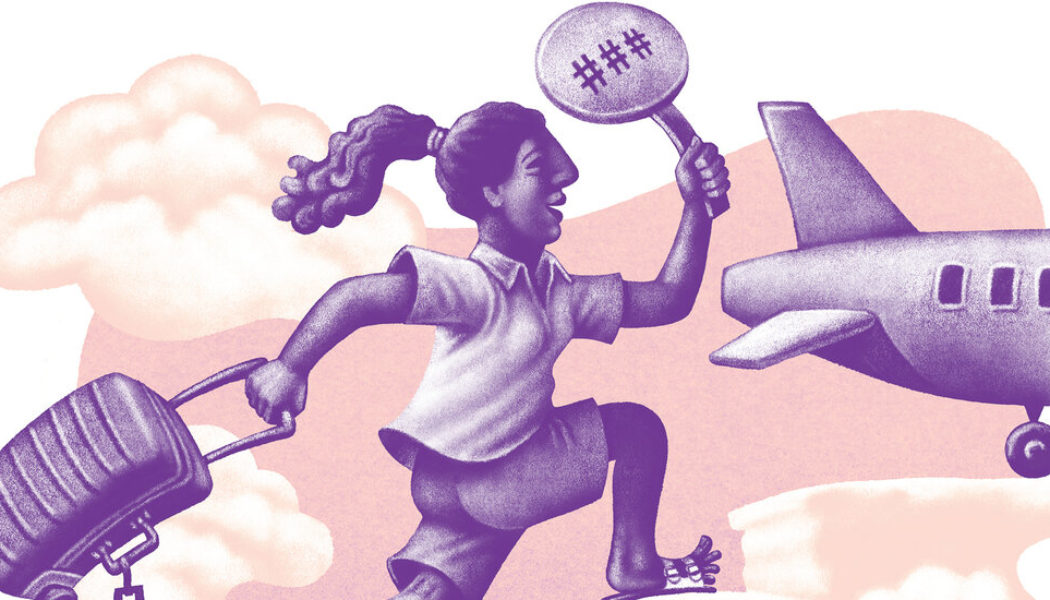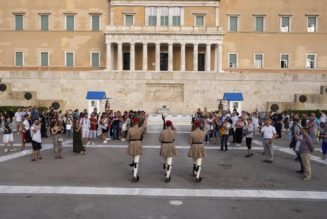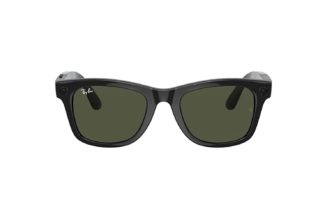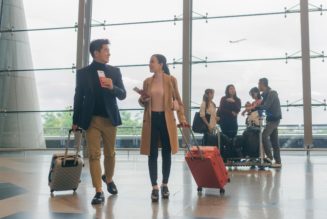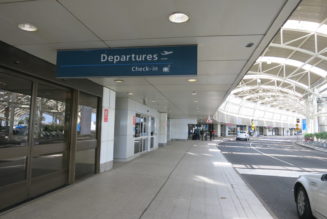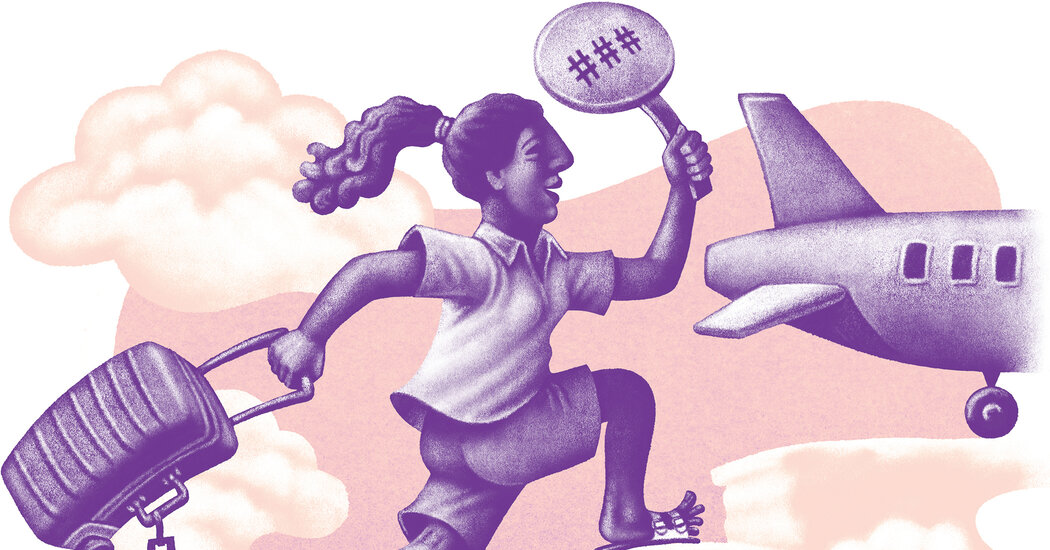
Fliers on some airlines can upgrade at a discounted rate to avoid what could be a cramped flight. With some cruise ships and even Amtrak getting in on the act, is bidding up worth it?
Flying to Tanzania for her honeymoon on Ethiopian Airlines in November, Amanda Meeks was ready to celebrate. So, when an email arrived inviting her to bid on business class seats for the leg of the journey between Addis Ababa, Ethiopia, and Mount Kilimanjaro in Tanzania, she jumped on it, getting two seats for the less-than-three-hour flight for $590.
“We absolutely felt like we were splurging,” said Ms. Meeks, a travel blogger in St. Louis, who paid $910 a person for her round-trip economy ticket from Chicago. Business class on the entire route can be five times that amount. “It was very much the ‘It’s our honeymoon, we only do this once, why not?’ mind-set.”
The why-nots among economy fliers are now generating what analysts believe may be millions of dollars for participating airlines that offer automated auctions for premium class seats on planes. The practice — growing among foreign carriers with scant pickup domestically — offers economy fliers the chance to upgrade at a discounted rate and improve what could be a cramped and sleepless long-haul flight.
“Travelers are happy to pay for things if it’s an experience they’re excited about,” said Ken Harris, the founder and chief executive of Plusgrade, a technology company founded in 2009 that currently works with about 125 travel businesses, including Qantas, Japan Airlines and Etihad Airways, to run upgrade auctions.
Businesses like Plusgrade, which generated $3.5 billion in business last year, according to the company, are booming in the post-lockdown return to travel as fliers look to treat themselves, and airlines have more premium seats available because of the continued slowdown in business travel.
“Airlines are trying to convert leisure customers to high-end leisure customers,” said Kevin Stamler, the founder and chief executive of SeatBoost, an auction service that currently works with three airlines, and has plans to start working with seven more this year. “It’s the cheapest way to upgrade.”
On two separate flights on foreign carriers last year, I was offered upgrade opportunities and made both winning and losing bids, which inspired me to look more closely at the practice. The following is what I learned, and explains why you might find upgrade auctions on your next flight, train ride or cruise.
How auctions work
Though participating airlines can set the terms and timing of the sales, most work like this: Within a week of departure, passengers get an email notifying them of an opportunity to bid on an upgrade. (Upgrades often are to business class but may also cover premium economy, a step up from economy with more legroom and often improved food and beverage service.)
The email usually sets a minimum bid, which is the threshold for participating, and sometimes a suggested bid above that. Bids apply to the total number of passengers in a reservation, so, for example, a $300 upgrade offer for a couple traveling together on the same booking would be $600 total. Bidding passengers supply a credit card for the payment in the event that it wins.
Most auctions are blind and fliers are notified of their win or loss within days or hours of departure.
How prices are set is vague. Last year on Austrian Airlines, I bid the minimum of 400 euros (then about $400) to fly in business class from Vienna to Chicago. My original economy ticket cost about $1,200 round trip; business class was close to four times that.
My bid was accepted and in addition to getting a lie-flat seat and better in-flight food, I gained access to the airport lounge, with more food and drink, work stations and sleeping pods, and my bag was among the first to come off the baggage carousel. For the start-to-finish 14-hour journey that spared me from the cramped coach class I experienced on the flight to Vienna, I thought the indulgence was worth it.
On a shorter flight in October, I bid the minimum, $200, on an Azores Airlines upgrade when returning from Ponta Delgada in the Azores to Boston, though the suggested starting bid was $250. I lost that campaign.
Both Plusgrade and SeatBoost said there was no formula to successful bidding, noting that flight dynamics, including how full a plane is, impacts auction results.
With SeatBoost, which works with Lufthansa, Avianca and TAP Air Portugal, auctions take place within three hours of a flight on the company’s app, which shows competing bids and where they rank. As at a live auction, bidders can raise their offers. Auctions normally end just a few minutes before boarding.
“We’re democratizing the upgrade process,” Mr. Stamler said.
Is upgrading worth it?
Whether upgrading is worth the expense is entirely subjective. The auction services say results vary but tend to net 20 to 30 percent savings on the price of an upgrade.
On fall flights between Toronto and Warsaw, Julia Gifford bid about $300, just above the minimum, for an outbound trip in premium economy on LOT Polish Airlines. The original round-trip economy fare was about $800.
“I upgraded both directions after an excellent first experience,” said Ms. Gifford, a Toronto native who lives in Riga, Latvia, where she runs a content marketing and public relations agency. She reported the food, the space and the mood of the flight attendants was much improved. “It was so worth it.”
While airline prices are notoriously dynamic, looking at the same routing on current flights, the difference between economy and premium economy prices for standard fares before any auction is usually more than $300. According to recent prices, a successful upgrade bid of $300 appears to save between 7 to 30 percent over the price at the time of booking.
“I would definitely recommend it to people who wish to fly business and are not sure if it’s worth it,” said Shamarel O.E. Odusanya, a psychologist based in Dubai, who won a business class upgrade for about the price she paid for her economy seat (995 Emirati dirhams, or roughly $270) on an Etihad Airways flight from Dubai to Tel Aviv and avoided a hefty fee for an extra checked bag because it was included in the upgrade ticket. “I particularly enjoyed the calm of the lounge, which made what can be a stressful experience a rather enjoyable one.”
Travelers may get other offers to upgrade directly from the airlines, sometimes immediately after they book a flight and even at the check-in counter at the airport.
Consumers set their threshold for engaging in auctions, which offers a degree of control.
“Ultimately, it’s a win-win for the airline and the traveler,” said Henry Harteveldt, a travel industry analyst who runs Atmosphere Research Group and recently won an upgrade auction to business class for $100 on a flight from Vienna to Warsaw, bringing the total cost of the ticket to $350, a third less than the $525 business class ticket available when he booked economy. “Airlines are collecting incremental revenue and being paid for a premium product. The passenger is winning because he or she is paying a price they feel is fair and meets their budget needs.”
Upgrade services are banking on the premise that fliers are looser with their budgets once travel is upon them.
“When people are booking, they’re extremely price sensitive,” Mr. Stamler said. “But your purchasing behavior changes when you’re traveling.”
What about domestic flights?
You’re more likely to buy an upgrade with cash or loyalty points on carriers based in the United States, where auctions are rare. Exceptions include Hawaiian Airlines, which operates many long-haul flights from the mainland to the islands.
Since 2021, Spirit Airlines has been using Plusgrade to auction its Big Front Seats (larger seats in the front rows) and exit row seats through a program it calls SeatBid. Fliers submit a bid through the website and are notified of its acceptance between 48 and two hours predeparture. Some flights offer an “Instant Level-Up” option at a discount to secure the upgrade immediately, similar to eBay’s “Buy It Now” option.
But the big three legacy airlines — American, Delta and United — don’t participate in premium class auctions. Often, empty seats in the forward cabins of planes are filled by frequent fliers upgraded by the airlines as a perk of loyalty.
“The U.S. carriers can’t fulfill demand for upgrades that they promised elite loyalty members,” Mr. Harteveldt said, adding that the airlines have been successful in pricing their premium and economy cabins in such a way that enough customers are upgrading during the booking stage.
Auction mania
Upgrade auctions have spilled over to other travel businesses, especially cruising.
Plusgrade began working with Norwegian Cruise Line in 2016. Since then, several lines have adopted the technology, including Carnival, Royal Caribbean and Virgin Voyages. In September, Princess announced its partnership with Plusgrade to offer cabin upgrades.
Given the variety of cabins on a cruise ship, passengers have options to upgrade from a standard inside cabin to a balcony cabin and beyond, including deluxe suites. Mr. Harris, the Plusgrade chief executive, said cruise upgrades have been popular, driven by the length of the trip.
Don Terris, an Ontario-based travel agent who analyzed the cruise upgrade bidding process in a YouTube video, won a bid at $1,500 on top of his basic fare to stay in a grand suite aboard a Royal Caribbean ship, which he said saved him more than $5,000 over booking the suite outright.
In 2021, Amtrak began auctioning its premium seats on trains with Plusgrade, which plans to roll out future auctions on train services in Europe.
There are plenty of websites that offer hotel booking discounts globally but few that offer upgrade auctions. Analysts say entry-level hotel rooms are not the equivalent of economy class airline seats.
“Airlines have done a remarkable job of making flying hell 30,000 feet above the earth,” Mr. Harteveldt said. “Auctions work because they start with the fact that economy class sucks and travelers will consider all reasonable options to escape it.”
Elaine Glusac writes the Frugal Traveler column. Follow her on Instagram @eglusac.
Follow New York Times Travel on Instagram, Twitter and Facebook. And sign up for our weekly Travel Dispatch newsletter to receive expert tips on traveling smarter and inspiration for your next vacation. Dreaming up a future getaway or just armchair traveling? Check out our 52 Places to Go in 2023.
